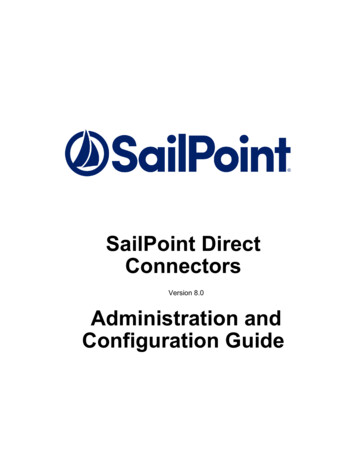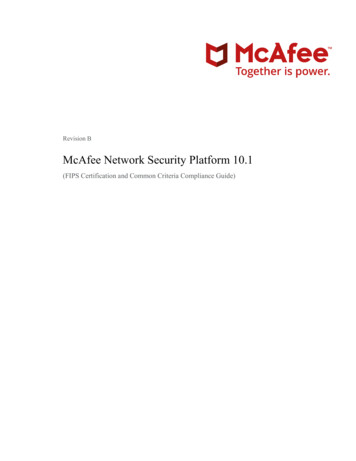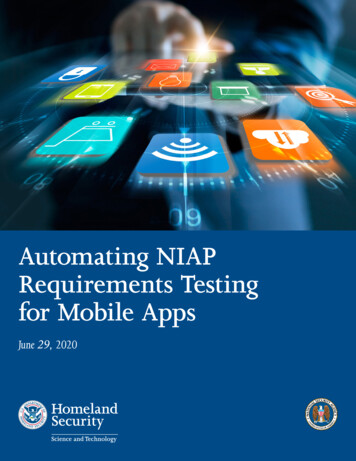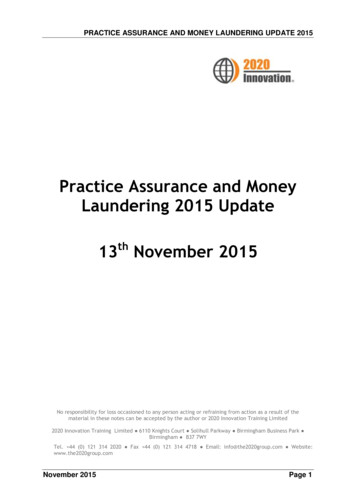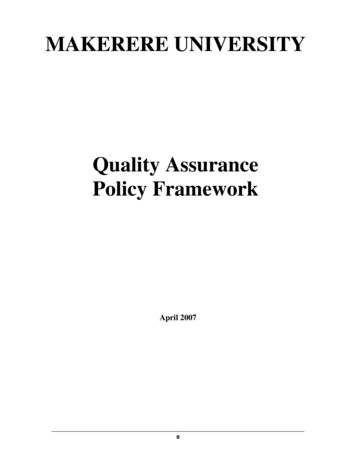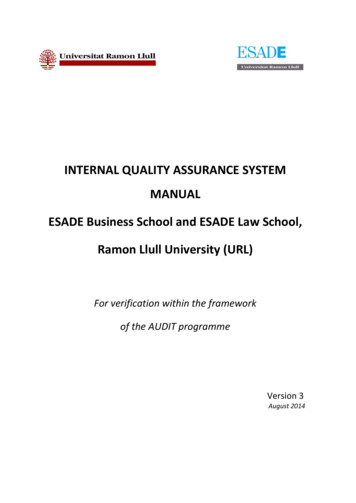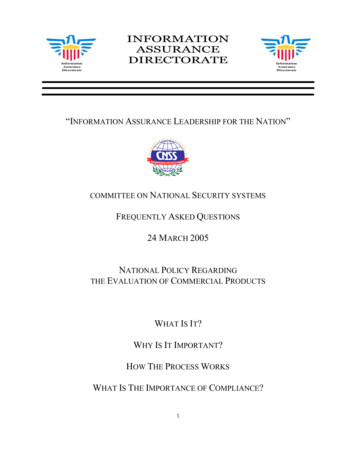
Transcription
RMATION ASSURANCE LEADERSHIP FOR THE NATION”COMMITTEE ON NATIONAL SECURITY SYSTEMSFREQUENTLY ASKED QUESTIONS24 MARCH 2005NATIONAL POLICY REGARDINGTHE EVALUATION OF COMMERCIAL PRODUCTSWHAT IS IT?WHY IS IT IMPORTANT?HOW THE PROCESS WORKSWHAT IS THE IMPORTANCE OF COMPLIANCE?1
EDIRECTORATEInformationAssuranceDirectorateThis FAQ is designed to answer common questions about the Committee on National Security Systems(CNSS) policy governing the acquisition of trusted products (i.e., NSTISSP #11). We have attempted tobe as clear, precise and accurate as possible. Comments and questions on the FAQ may be directed at tothe NSA IA Service Center (NIASC) at 1-800-688-6115 option 3.Contents(I) General1. What is NSTISSP #11?2. Why is there a need for a national IA acquisition policy like NSTISSP #11?3. What is the objective of NSTISSP #11?4. How should NSTISSP #11 be viewed?5. Why is NSTISSP #11 so important?6.What are the advantages of testing in accordance with International Standards such as theCommon Criteria?(II) Policy Information and Guidance1. Is there any acquisition guidance for COTS products under NSTISSP #11?2. To whom does NSTISSP #11 apply?3. To what products does NSTISSP #11 apply?4. Are all systems processing classified information considered National Security Systems?5. Does NSTISSP #11 validation of products replace system certification testing?6. What guidance is available regarding "the appropriate combinations and implementation ofGOTS, COTS IA and IA-enabled products"?7. Does NSTISSP #11 apply to all components of a large system?8. What other related NSTISSP #11 documents exist?9. How can I find out what products have already been tested by NIST's FIPS 140 CryptographicModule Validation Program (CMVP) or by the NIAP?10. What do I do if the commercial product I want to purchase is not on the NIAP or NIST validatedproducts list?2
EDIRECTORATEInformationAssuranceDirectorate11. Do products validated in the United States receive preferential treatment over products validatedelsewhere?12. Is there an NSTISSP #11 waiver process?13. I have already purchased a COTS product, but it is not yet validated or fielded. Do I need to haveit evaluated by NIAP CCEVS?14. I have purchased a service agreement with my COTS product which gives me updates andpatches over the lifetime of the product. Do each one of these updates/patches need to be testedby NIAP CCEVS?15. I have a number of COTS products in an already fielded and accredited system. How doesNSTISSP #11 apply to me?16. My organization negotiates indefinite delivery/indefinite quantity (ID/IQ) agreements withvendors. How does NSTISSP #11 COTS testing requirements apply to these types ofarrangements?17. I am a government product program manager building a system comprising numerous IA/IA-enabled COTS products that will be purchased by government customers for use in their systems.How does NSTISSP #11 apply to my program?(III) Definitions1. What is the NSTISSC (recently renamed to the CNSS)?2. What is a National Security System?3. What are IA products? How do they differ from IA-enabled products?4. What is a COTS product?5. What is the nature of a GOTS product?6. Is the evaluation different for COTS and GOTS products?7. What is security robustness?(IV) NIAP and the Common Criteria1. What is the NIAP?2. What is CCEVS? What is its purpose?3. What is the CMVP?4. What is the Common Criteria?3
EDIRECTORATEInformationAssuranceDirectorate5. What is a Protection Profile (PP)?6. Do any Protection Profiles exist? Where?7. Can I write a Protection Profile?8. What is a Security Target (ST)?9. How can I find out what products have been CCEVS validated?10. Is a NIAP/NIST validated product secure?11. What are Evaluation Assurance Levels (EALs)?12. Can I get Common Criteria training?13. What is the Common Criteria Mutual Recognition List?14. What is the relationship of NIAP's CCEVS and NIST's Cryptographic Module ValidationProgram (CMVP)?15. What U.S. laboratories have been approved to perform CC and PP evaluations?(V) Developers and NSTISSP #111. What are Protection Profile compliant products? Should I attempt to make my product compliant?2. Should I attempt to get my product evaluated before a prospective customer requests one?3. How do I get a GOTS product validated?4. How much does an evaluation cost?5. What do I do to start a Common Criteria evaluation? How does the process work?6.I have a product which contains a cryptographic module along with other mechanisms toimplement separate security features. Do I need two evaluations? Why? What is the relationshipbetween the CCEVS and the CMVP?(VI) NSTISSP #11 and National Security System Product Testing Programs1. Do products for which NSA has produced Configuration Guidance meet NSTISSP #11 validationrequirements?2. Do SABI/TSABI approved COTS IA/IA-enabled products qualify as "validated" under NSTISSP#11?3. What is the difference between NIAP CCEVS evaluated products and NSA approved products?4
EDIRECTORATEInformationAssuranceDirectorate(I) General1. What is NSTISSP #11NSTISSP #11 is a national security community policy governing the acquisition of information assurance(IA) and IA enabled information technology products. The policy was issued by the Chairman of theNational Security Telecommunications and Information Systems Security Committee (NSTISSC), nowknown as the Committee on National Security Systems (CNSS) in January 2000 and revised in June2003. . The policy mandates, effective 1 July 2002, that departments and agencies within the ExecutiveBranch shall acquire, for use on national security systems, only those COTS products or cryptographicmodules that have been validated with the International Common Criteria for Information TechnologySecurity Evaluation, the National Information Assurance Partnership (NIAP) Common CriteriaEvaluation and Validation Scheme (CCEVS), or by the National Institute of Standards and Technology(NIST) Federal Information Processing Standards (FIPS) Cryptographic Module Validation Program.Additionally, subject to policy and guidance for non-national security systems, NSTISSP # 11 notes thatdepartments and agencies may wish to consider the acquisition of validated COTS products for use ininformation systems that may be associated with the operation of critical infrastructures as defined in thePresidential Decision Directive on Critical Infrastructure Protection (PDD-63).The revised NSTISSP #11 added the Deferred Compliance Authorization (DCA) that states, “No blanketor open-ended waiver to NSTISSP No.11 will be authorized, but a DCA1 may be granted on a case-bycase basis.” Departments and agencies electing to pursue a DCA from the policy requirement ofNSTISSP #11 shall use the guidelines and procedures provided in NSTISSP No. 11, Revised Fact Sheet(July 2003) .2. Why is there a need for a national IA acquisition policy like NSTISSP #11?The technology advances and threats of the past decade have drastically changed thinking and approachesto protecting national security systems and information. The U.S. Government has migrated from theexclusive use of Government Off-the-Shelf (GOTS) products to a mix of Commercial Off-the-Shelf(COTS) and GOTS products for the protection of information within our national security systems. Theproliferation of COTS information assurance (IA) products such as firewalls and Intrusion DetectionSystems, as well as IA-Enabled products such as operating systems and database management systemswith security attributes, has provided the community of users with a multitude of security products tochoose from. All of the products come with their own specific claims relative to the security robustnessthey provide. In this context, it is important that COTS IA and IA-enabled IT products acquired by theU.S. Government Departments and Agencies be subject to a standardized evaluation process that willprovide some validation that these products perform as advertised.3. What is the objective of NSTISSP #11?The objective of NSTISSP #11 is to ensure that COTS IA and IA-enabled IT products acquired by theU.S. Government for use in national security systems perform as advertised by their respectivemanufacturers, or satisfy the security requirements of the intended user. To achieve this objective, the1A Deferred Compliance Authorization (DCA) is a formal approval by an authorized official to defer compliancewith the requirement of a national IA policy for a specified period of time, normally not to exceed more than onecalendar year.5
EDIRECTORATEInformationAssuranceDirectoratepolicy requires COTS products be evaluated and validated in accordance with either the InternationalCommon Criteria for Information Technology Security Evaluation, or the National Institute of Standardsand Technology (NIST) Federal Information Processing Standard (FIPS) 140-2. Supportive of the intentand implementation of NSTISSP #11, the NSA and NIST have collaborated to establish the followingtwo evaluation and validation programs: The National Information Assurance Partnership's (NIAP)Common Criteria Evaluation and Validation Scheme (CCEVS) Program and the NIST FederalInformation Processing Standard (FIPS) Cryptographic Module Validation Program (CMVP) each whichtarget different, but complementary, areas.4. How should NSTISSP #11 be viewed?NSTISSP #11 should be viewed as a tool for evaluating the security functionality provided by COTS IAand IA-enabled IT products at various robustness levels. A comprehensive risk management programmust be considered from the outset in the design, acquisition and operation of all Information Technology(IT) systems. During the initial design phase of any information system, security considerations must beincluded. However, compliance with the policy in its most simplistic form (i.e., feel comfortable that aproperly evaluated product has been acquired), should not be viewed as an "end result" IA solution in andby itself. The use of properly evaluated products certainly contributes toward the security and assuranceof the overall system where they are employed and should be an important factor in IT procurementdecisions. From an overall security perspective, however a properly evaluated product is only a part of thesecurity solution. Other complementary controls are needed including sound operating procedures,adequate training, overall system certification and accreditation, sound security policies and welldesigned system architectures.5. Why is NSTISSP #11 so important?NSTISSP #11 is a critical policy component of the U.S. Government's overall Information Assurance(IA) strategy. A wide variety of products are available to satisfy a diversity of security requirements toinclude providing confidentiality for data, as well as authenticating the identities of individuals ororganizations exchanging sensitive information. In terms of design, quality and performance, theseproducts run the gamut from "terrific to terrible". It is imperative that policies and processes beestablished to validate the performance claims of marketed IA products, and to ensure that these productsare responsive to the security needs of the intended user. In the context of national security systems andinformation, these requirements take on added significance and importance. NSTISSP #11 is a binding,national policy requirement. Acquirers, users and vendors of IA products are encouraged to familiarizethemselves with the policy and its associated processes, and to ensure, effective 1 July 2002, fullcompliance with its documented requirements.6. What are the advantages of testing in accordance with International standards such as theCommon Criteria?The advantages of using international standards are that commercial vendors (either domestic or foreign)are not limited to having their products tested within their own countries. Any commercial testinglaboratory accredited as compliant with the Common Criteria Recognition Arrangement (CCRA) canperform evaluations up to and including evaluations at the EAL 4 level. This arrangement ensures that6
ted laboratories, regardless of their geographic location or national affiliation, will test productsagainst the same criteria and use the same testing methodology.The United States, Canada, France, Germany, the Netherlands and the United Kingdom are all chartermembers of the Common Criteria Recognition Arrangement that was signed in October of 1998. Sincethat time, Australia, New Zealand, Finland, Greece, Israel, Norway, Spain, Italy, Hungary, Turkey,Republic of Singapore and Sweden have also become members. Of these nations, the United States,Canada, France, Germany, the United Kingdom Australia/New Zealand (combined) and Japan haveprograms in place to evaluate COTS IA and IA-enabled IT products against the Common Criteria. Theremaining nations do not have evaluation programs, but have agreed to accept the certificates produced bythose nations that do have evaluation programs.Based on the need for good security products, as well as the plethora of products and services available onthe commercial market, consistency and efficiency are desirable objectives. The use of recognized,common standards within the structure of NIAP and NIST provide the mechanisms for accomplishingthose objectives. Specifically: The evaluations of IT products and protection profiles are performed against high and consistentstandards that are seen as contributing significantly to the confidence in the security of thoseproducts and profiles; The framework of the Common Criteria increases the availability of evaluated, security-enhancedIT products and profiles for national implications; Duplicative evaluations of IT products and protection profiles are eliminated; and Continuous improvements in the efficiency and cost-effectiveness of security evaluations and thecertification/validation processes for IT products and protection profiles are achieved.7
EDIRECTORATEInformationAssuranceDirectorate(II) Policy Information and Guidance Contents1. Is there any acquisition guidance for COTS products under NSTISSP #11?Acquisition guidance for COTS products that contain cryptographic modules used by the U.S.Government to protect UNCLASSIFIED information within computer and telecommunications systemshas not changed. NSTISSAM INFOSEC/1-00, dated 8 FEB 2000, is the Advisory Memorandum for theUse of FIPS 140 Validated Cryptographic Modules in Protecting Unclassified National Security Systems.FIPS 140 is applicable to all Federal agencies that use cryptographic-based security systems to protectsensitive information in computer and telecommunication systems (including voice systems) as defined inSection 5131 of the Information Technology Management Reform Act of 1996, Public Law 104-106.This standard shall be used in designing and implementing cryptographic modules that Federaldepartments and agencies operate or are operated for them under contract. Cryptographic modules thathave been approved for classified use may be used in lieu of modules that have been validated against thisstandard. For FIPS compliant cryptographic modules, products from the NIST CMVP Validation Listshould be selected.The recommended acquisition approach for products containing non-cryptographic IA or IA-enabledfeatures is as follows. First, choose a product from the NIAP CCEVS Validated Products List that iscompliant with the requirements of a government sponsored protection profile for the desired technology(e.g., firewalls). In the absence of any products that are compliant with a government sponsoredprotection profile, or where there is no government sponsored protection profile for that particulartechnology, the consumer should choose from the CCEVS Validated Products List an evaluated productfrom the desired technology that has met its security target requirements. Lastly, where no evaluated orvalidated product is on the CCEVS Validated Products List, the consumer should check the CCEVSProducts and Protection Profiles In Evaluation List for a potential product. All proposed contracts foracquisition of IA or IA-enabled IT products should contain language that very specifically documents therequirement for NSTISSP #11 validated products. This can be accomplished in two ways:1. If an approved U.S. Government protection profile exists for a particular technology area, but novalidated products that conform to the protection profile are available for use, the acquiringorganization must require, prior to purchase, that vendors submit their products for evaluation andvalidation by a NIAP laboratory or CCRA laboratory to a security target written against theapproved protection profile or acquire other U.S.-recognized products that have been evaluatedunder the sponsorship of other signatories to the CCRA2. If no U.S. Government protection profile exists for a particular technology area and the acquiringorganization chooses not to acquire products that have been evaluated by the NIAP CCEVS orCCRA laboratories, then the acquiring organization must require, prior to purchase, that vendorsprovide a security target that describes the security attributes of their products, and that vendorssubmit their products for evaluation and validation at a DAA-approved EAL. Robustnessrequirements, mission, and customer needs will together enable an experienced informationsystems security engineer to recommend a specific EAL for a particular product to the DAA. Inaddition, the organization should file the necessary for a DCA (see FAQ #12 under Policyinformation and Guidance).8
EDIRECTORATEInformationAssuranceDirectorateThe recommended acquisition approach for products containing both cryptographic modules and IAor IA-enabled features is as follows. Apply the procedures for non-cryptographic IA or IA-enabledfeatures as described above and ensure that any cryptographic modules included in the product meetsthe FIPS criteria described above. If there are no products that meet the FIPS and NIAP criteria,apply the rules outlined in 1 and 2 above and apply for DCA noted in #2 above for non-cryptographicIA or IA-enabled features and the waiver process outlined in the FIPS 140-2 standard forcryptographic modules.2. To whom does NSTISSP #11 apply?All departments and agencies in the Executive Branch that acquire COTS products for use in nationalsecurity systems. Departments and agencies associated with the operation of critical infrastructures asdefined in the Presidential Decision Directive on Critical Infrastructure Protection (PDD-63), may wish toconsider the acquisition of validated COTS products for use in ‘critical’ information systems.3. To what products does NSTISSP #11 apply?NSTISSP # 11 applies to products being acquired for national security systems used to enter, process,store, display, or transmit national security information. The policy applies only to departments andagencies within the Executive Branch of the U.S. Government. Departments and agencies responsible forgoverning non-national security systems but considered part of the of critical infrastructure as defined inthe Presidential Decision Directive on Critical Infrastructure Protection (PDD-63), may wish to considerthis policy in their implementation IA procurement strategy.4. Are all systems processing classified information considered National Security Systems?Yes. See E.O. 12958.5. Does NSTISSP #11 validation of products replace system certification testing?No. For national security systems, composite system level certification analysis and testing is stillrequired per the local Designated Accrediting Authority requirements (e.g., DITSCAP, NIACAP). Thehope is that using validated products will aid in increasing security of systems in development byallowing organizations to make more informed security decisions before procurement, and decrease theeffort required for composite system testing before Accreditation.6. What guidance is available regarding "the appropriate combinations and implementation ofGOTS, COTS IA and IA-enabled products"?The National Security Agency, as well as numerous support contractors offer Information SystemSecurity Engineering services that provide guidance on secure architectures, risk management and riskmitigation. To receive such services from NSA, call the NSA Information Assurance Service Center at 1800-688-6115 option 3 or (410) 854-7661 for more information.9
EDIRECTORATEInformationAssuranceDirectorate7. Does NSTISSP #11 apply to all components of a large system?NSTISSP #11 applies to all IA and IA-enabled IT products in a given solution. Whether a component isconsidered an IA/IA-enabled IT component depends heavily on the nature of the architecture in which itis being placed. If the component is not "cognizant" of the security policy and has no security policyenforcement responsibilities (i.e. it is not required to make policy enforcement decisions or implement asecurity feature), it is not considered to be an IA/IA-enabled IT component and hence will not need to bevalidated. On the other hand, if the component is "cognizant" of the security policy and makes securitydecisions or implements security features, it is considered to be an IA/IA-enabled IT component and mustbe validated. To illustrate this, consider an architecture where an operating system may be required toenforce an access control policy because it is being used to separate multiple users from each other. Inthis case, the operating system is considered to be an IA-enabled IT component because it must enforceisolation with access control decisions. For another architecture, the same operating system may not beresponsible for enforcing or implementing separation of users (i.e. it is being used only as a dumbterminal) because the architecture calls for it to be a "single user" system which is connected to a networkwhere all security services are implemented on a network server. In this architecture, the operating systemwould not be considered an IA-enabled IT component, and hence not require CC evaluation/validation.8. What other related NSTISSP #11 documents exist?There are numerous Department of Defense and Civilian policy documents that reference or are related toNSTISSP #11. NIAP has selected policy and guidance documents. The U.S. Department of Defensemaintains the DoD issuances web site where DoD Directive 8500.1 mandates NSTISSP # 11 compliance.NIST Special Publication 800-23 "Guidelines to Federal Organizations in Security Assurance andAcquisition/Use of Tested/Validated Products" references NSTISSP #11. Information TechnologyManagement Act (Clinger/Cohen Act) defines national security systems and national securityinformation.9. How can I find out what products have already been tested by NIST's FIPS 140 CryptographicModule Validation Program (CMVP) or by the NIAP?Validated Cryptographic Modules can be found on the CMVP Validated Modules List. Products that havebeen evaluated against the International Common Criteria for Information Technology SecurityEvaluation can be located on the CCEVS NIAP Validated Products List or the Common CriteriaValidated Products.10. What do I do if the commercial product I want to purchase is not on the NIAP or NISTvalidated products list?If the product contains a cryptographic module and that cryptographic module is not on the CMVPValidated Modules List, then the product cannot be purchased. If the product contains non-cryptographicIA or IA-enabled features and is not on the CCEVS or Common Criteria Validated Products List, theacquisition contract must require Common Criteria evaluation/validation as a condition of purchase. Seequestion 12 on the Deferred Compliance Authorization.10
EDIRECTORATEInformationAssuranceDirectorate11. Do products validated in the United States receive preferential treatment over productsvalidated elsewhere?Cryptographic COTS products used by the U.S. Government must be validated by the NISTCryptographic Module Validation Program (CMVP). The CMVP was established by NIST and theCommunications Security Establishment (CSE) of the Government of Canada in July 1995. All of thetests under the CMVP are handled by third-party laboratories that are accredited as Cryptographic ModuleTesting (CMT) laboratories by the National Voluntary Laboratory Accreditation Program (NVLAP).There are currently nine CMT laboratories located in the U.S., Canada, and UK. Testing at any laboratoryis recognized by the CMVP and upon successful testing, cryptographic modules, which are validated areadded to the CMVP Validated Modules List.For non-cryptographic COTS IA/IA-enabled IT products evaluated at EAL1- EAL4, evaluations may beperformed at one of the U.S. accredited Common Criteria Testing Laboratories (CCTLs) or an accreditedCCTL recognized under the Common Criteria Recognition Arrangement. Products whose evaluationshave assurance components above EAL 4 must be evaluated in the U.S., for that portion that is aboveEAL 4, before they are placed on the CCEVS Validated Products List.12. Is there an NSTISSP #11 waiver process?No blanket or open-ended waivers to NSTISSP No. 11 will be authorized, but a Deferred ComplianceAuthorization (DCA)2 may be granted on a case-by-case basis. See NSTISSP No. 11, Revised Fact Sheet(July 2003) for details.13. I have already purchased a COTS product, but it is not yet validated or fielded. Do I need tohave it evaluated by NIAP CCEVS?If the product contains a cryptographic module, NSTISSAM INFOSEC 1/00 requires that thecryptographic module must undergo FIPS testing prior to being used to protect UNCLASSIFIEDinformation. If the product does not contain a cryptographic module, the answer is no. Although this mayseem counter-intuitive, NSTISSP #11 is an acquisition policy, and as such it is invoked as part of theinitial procurement activity and does not apply to IA/IA-enabled products that have already beenacquired, the DAA (Designated Accrediting Authority) makes the “use” decision. The key to whetherNSTISSP #11 Common Criteria testing applies is based on when the contract was signed. If theprocurement agreement is signed prior to July 1, 2002, COTS IA/IA-enabled testing through anaccredited Common Criteria Testing Laboratory (CCTL) is not required. If it is signed after July 1, 2002,COTS IA/IA-enabled testing through a CCTL is required.14. I have purchased a service agreement with my COTS product, which gives me updates andpatches over the lifetime of the product. Do each one of these updates/patches need to be tested byNIAP CCEVS?2A Deferred Compliance Authorization (DCA) is a formal approval by an authorized official to defer compliancewith the requirements of a national IA policy for a specified period of time, normally not to exceed more than onecalendar year.11
EDIRECTORATEInformationAssuranceDirectorateIn the context of NSTISSP #11, whether or not COTS IA/IA-enabled testing is required will be basedupon when two parties legally agree upon a price and a product. When funds actually change hands orwhen the product is actually obtained is irrelevant to whether NSTISSP #11 COTS testing is required ornot. Specifically for the DoD community, the following policy words apply:Acquiring DoD organizations that anticipate using the IA functionality of subsequent versions ofan evaluated product shall specify in the original contract that product validation will be keptcurrent through vendors submitting the next version of their products for evaluation or throughparticipation in the NIAP Assurance Maintenance Program or the CCRA Assurance MaintenanceProgram.Products that are available under multiple-award schedule contracts or non-DoD GovernmentWide Acquisition Contracts awarded before July 1, 2002, must be evaluated when and if aversion release of the product is made available under the contract.Implementation of security-related software patches directed through the DoD IAVA programshall not be delayed pending evaluation of changes that may result from the patches.15. I have a number of COTS products in an already fielded and accredited system. How doesNSTISSP #11 apply to me?As an acquisition policy, NSTISSP #11 testing applies only to the acquisition of new products. NSTISSP#11 does not require testing of COTS products that are already fielded.16. My organization negotiates indefinite delivery/indefinite quantity (ID/IQ) agreements withvendors. How does NSTISSP #11 COTS testing requirements apply to these types of arrangements?For the purposes of determining whether NSTISSP #11 COTS testing is required or not, an agreement isconsidered to be a "contract" when two parties legally agree upon a price and a product. When fundsactually change hands or when the product is obtained is irrelevant to whether NSTISSP #11 COTStesting is required or not. Therefore, if the IDIQ agreement notes an agreed upon price and product (withfunds changing hands at a future date) and it is signed before July 1, 2002, COTS testing is not requiredfor "buys" against that agreement. However, once the agreement is renegotiated (after July 1, 2002), itmust include a provision for COTS tested products.17. I am a government product program manager building a system comprising numerous IA/IAenabled COTS products that will be purchased by government customers for use
INFORMATION ASSURANCE DIRECTORATE 2 Information Assurance Directorate Information Assurance Directorate This FAQ is designed to answer common questions about the Committee on National Security Systems (CNSS) policy governing the acquisition of trusted products (i.e., NSTISSP #11). We have attempted to be as clear, precise and accurate as possible.
